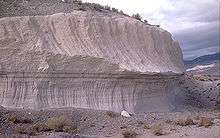Bishop Tuff

The Bishop Tuff is a welded tuff that formed 767,100 ± 900 years ago as a rhyolitic pyroclastic flow during the eruption that created the Long Valley Caldera.[1] Large outcrops of the tuff are located in Inyo and Mono Counties, California, United States.
Modern exposure
.png)
The Bishop Tuff caps a volcanic plateau in the northern Owens Valley. The tableland formation is located east of U.S. Route 395 and west of the Nevada stateline, sitting northwest of Bishop and southeast of Crowley Lake and Mammoth Lakes. Another part of the flow is south of Mono Lake, and surrounding the Mono-Inyo Craters.
Deposits of Bishop Tuff in this area cover nearly 2,200-square-kilometer (850 sq mi), and range in thickness from 150-meter (490 ft) to 200-meter (660 ft).
The Owens River cut through the volcanic plateau, creating the Owens River Gorge.
Film Appearances
One of the monsters from the 1990 film Tremors exits from the Bishop Tuff close to Bishop
See also
References
- ↑ Crowley, J.L.; Schoene, B.; Bowring, S.A. (December 2007). "U-Pb dating of zircon in the Bishop Tuff at the millennial scale". Geology. 35 (12): 1123–1126. doi:10.1130/G24017A.1. Retrieved 26 September 2010.
External links
| Wikimedia Commons has media related to: |
Coordinates: 37°30′N 118°30′W / 37.5°N 118.5°W